Scientific name: Agave parryi
Common names: Parry’s agave, mescal agave
Family: Asparagaceae, sub-family Agavoideae
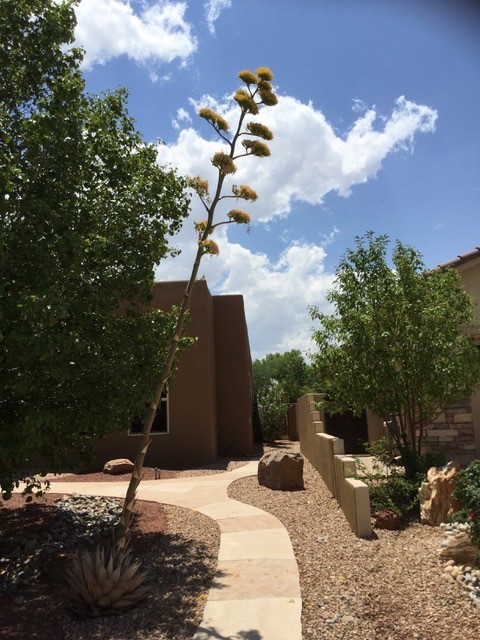
Photo by Jeanne Gozigian.
Also mentioned: American century plant (Agave americana), monument plant (Frasera speciosa)
Article by Jeanne Gozigian
Look up in the sky! It’s a bird, it’s a plane! No, it’s a giant stalk of asparagus, reaching for the sky! The flowering stalk of Agave parryi, (a-Gah-vee Pair-ree-eye), fifteen to twenty feet tall, will be crowned with branches resembling a candelabra and flowers that start as red buds, opening to become yellow/green blooms in panicles at the branch ends.
Carl Linnaeus, the renowned Swedish botanist (1707-1778), founder of the binomial system for naming organisms coined the name, Agave. It is from the Greek, agaous, meaning noble or admirable, probably because of their tall flowering spikes.
The amazing Parry’s agave, named for Dr. Charles Christopher Parry, the 19th century English-born American botanist, is one of the monocarpic plants that blooms only once in its lifetime of ten to twenty years or more, depending on the climate in which it grows. Other monocarpic plants are Agave americana (a-mer-ih-KAY-na) or American century plant, and Frasera speciosa (FRAY-zer-uh spee-see-OH-suh) or monument plant, in the Gentianaceae family.
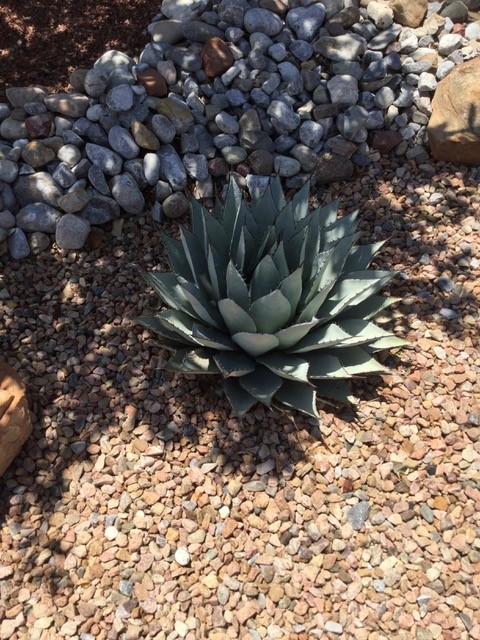
Photo by Jeanne Gozigian
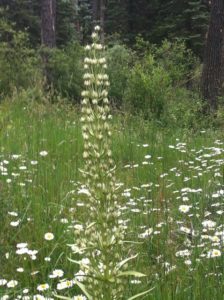
Monument plant (photo by Leigh Gozigian)
All of these plants start with basal rosettes, forming flowering spikes in the last years of their lives. That can be from twenty to eighty years for Frasera speciosa , typically growing in the mountain meadows of Colorado. Then, the basal rosette dies, but monocarpic plants can reproduce from seeds and off shoots or “pups” from the main plants.
In 2010, thousands of Frasera speciosa bloomed at the same time, their five-foot tall spikes gracing the mountains. Botanists were puzzled, but suspected that a very wet July and August, four years previously, may have been the cause. The Agaves are very drought tolerant succulents with gray-green or gray-blue leaves. The foliage, which stores water, has a waxy coating that prevents water loss. They are very effective grown in cactus gardens as they do not need water after the initial planting. All of the leaves have wicked brownish spikes at the tips that can inflict damage so care must be taken with children around. In a November 23, 2007, article by “Mr. Smarty Pants”, part of the Lady Bird Johnson Wildflower Center, recommended A. americana for use as a privacy screen; it would absolutely stop foot traffic!
A. americana is not as frost hardy as parryi. A. americana is ideally grown in zones 8-10, while A. parryi is happiest in 7-10, but does well in Santa Fe, NM, in zone 6b. But both must be grown in dry cold in order to tolerate lower temperatures . Warm winter rains followed by freezes can cause ice crystals to form in the leaves, immediately killing the plants. They are best grown in a variety of soil types in full sun, but must have good drainage; otherwise, root rot could result, leading to death of the plants. Their only problems appear to be agave weevils and slugs and snails, which can damage the foliage.
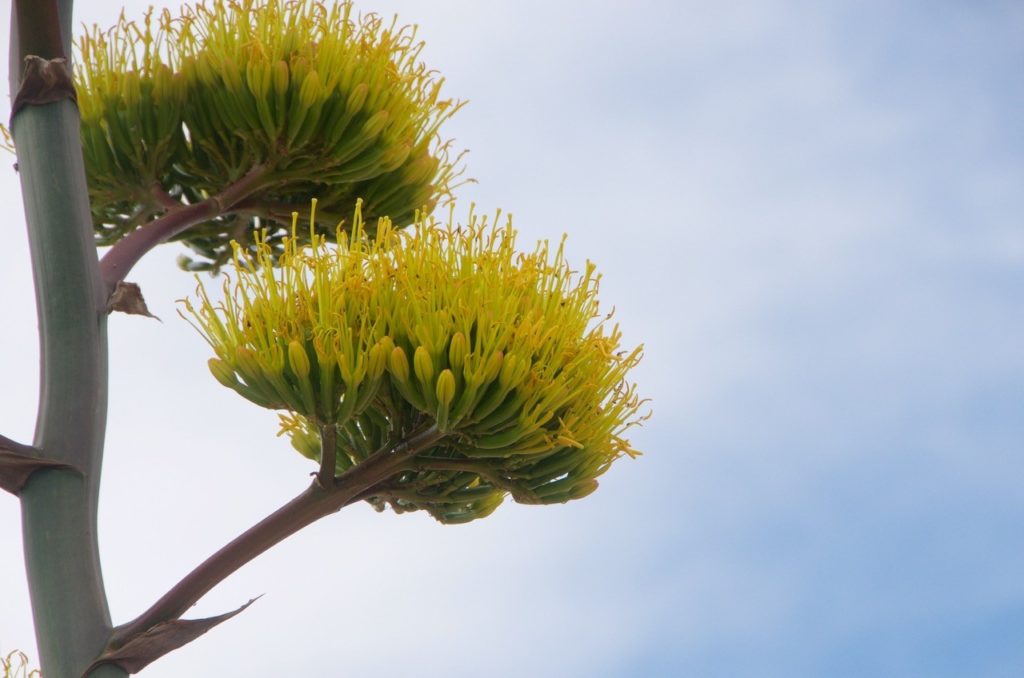
Agave flowers by Janice Tucker
The basal rosette of evergreen, lanceolate leaves in A. parryi, an herbaceous perennial, can reach two feet to three feet in width and one and one half feet or two feet in height. The agave species are hermaphroditic, that is, they have both male and female organs. A. americana leaves can be three to five feet long and the basal rosette can spread six to ten feet. The astonishing flowering stalk could grow from twenty -five to thirty feet tall and americana can live twenty-five to thirty years. These succulents are native to southwestern USA, California and Mexico.
In Mexico, the stem is cut before flowering to gather aguamiel (honey water) from the heart (pina) of the plant and then fermented to make pulque. The tequila producing regions gather mezcales, agave plants, to produce mezcal, a distilled spirit often flavored with a mezcal worm.
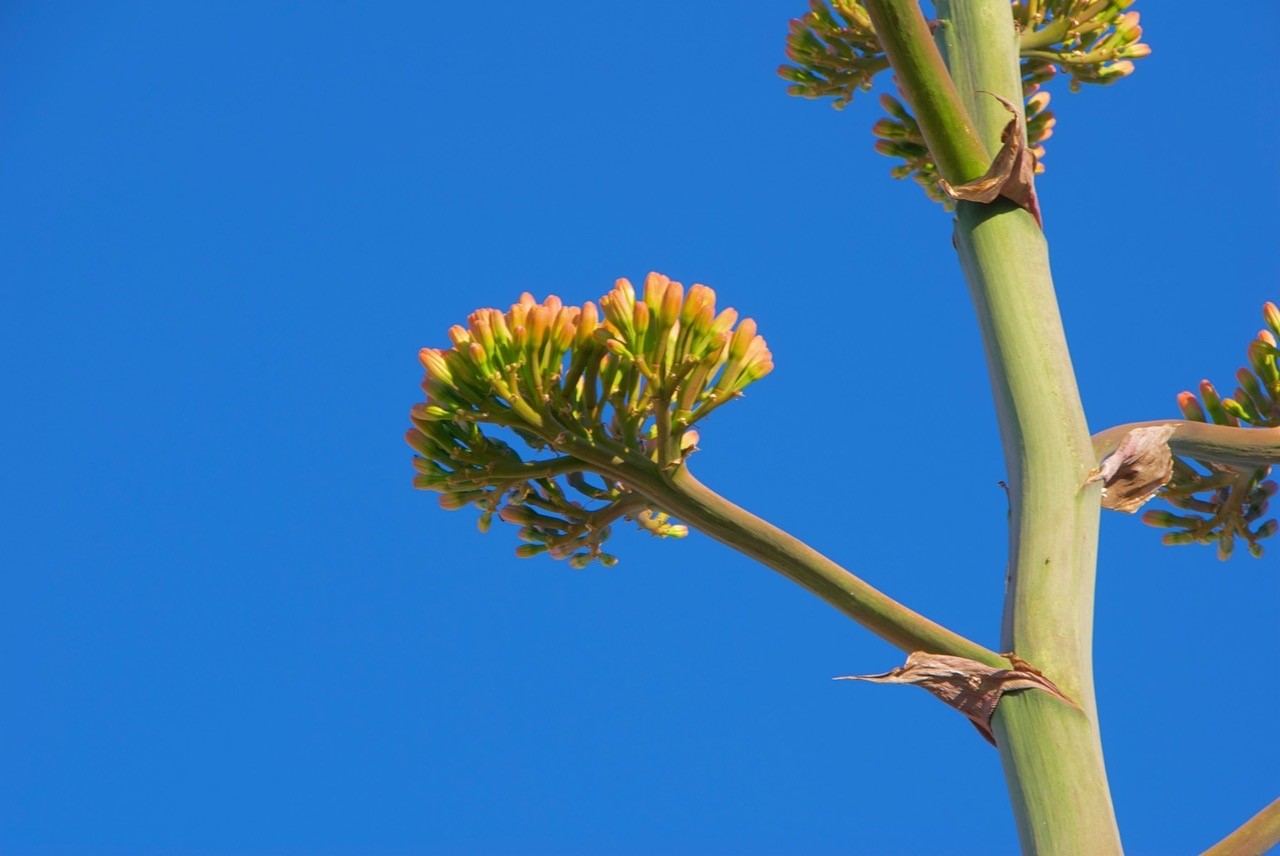
Agave flowers in bud by Janice Tucker
Agave nectar, a natural sugar with a high fructose content and low glycemic index, is preferred by many as a healthier sugar substitute. A. americana and A. parryi are not typically used for mezcal production, but can be. All parts of the agaves are edible: Leaves, sap, seeds, stems and hearts have traditionally been used. The stems can be roasted and eaten like asparagus. The leaves contain saponins, used to make soap. Dubious medical uses include as an antiseptic, diaphoretic, diuretic, and laxative. As always, don’t try this at home! It is said that the sap can be used as an insecticide. The fibers from agave species were important for making ropes and mats, while the terminal spine could serve as a needle and thread.
Both of the agaves can be grown as houseplants but they will never bloom if grown in pots. They are commercially available in this form. They must be abandoned as houseplants when they reach two feet in width. The use of gloves is mandatory because of the very sharp spikes. A. parryi are frequent landscape plants in my neighborhood north of Albuquerque, New Mexico, with many blooming and dying in this month of July. At the Botanical Garden at Museum Hill, in Santa Fe, New Mexico, A. parryi occurs in the Orchard Garden.
Thanks go to Janice Tucker and Helen Woody for proofreading this article.
Sources:
“Agave americana.” Lady Bird Johnson Wildflower Center. Web. 20 August 2018. https://www.wildflower.org/plants/resultphp?id_plant=AGAM
“Agave americana.” Plant Finder, Missouri Botanical Garden. Web. 20 August 2018.
http://www.missouribotanicalgarden.org/PlantFinder/PlantFinderComments.aspx?taxonid=275719
“Agave americana.” Plants For A Future. Web. 20 August 2018. https://pfaf.org/USER/Plant.aspx?LatinName=Agave+americana
“Agave parryi.” Lady Bird Johnson Wildflower Center. Web. 20 August 2018. https://www.wildflower.org/plants/result.php?id_plant=AGPA4
“Agave parryi.” Plant Finder, Missouri Botanical Garden. Web. 20 August 2018.
https://missouribotanicalgarden.org/PlantFinder/plantFinderDetails.aspx?kempercode=e965
“Agave parryi.” Garden Explorer, Santa Fe Botanical Garden. Web. 20 August 2018. https://santafebotanicalgarden.gardenexplorer.org/taxon-254.aspx.
“Agave parryi.” SEINet Portal Network, Arizona-New Mexico Chapter. Web. 20 August 2018. http://swbiodiversity.org/seinet/taxa/index.php?taxon=Agave%20parryi&formsubmit=Search+Terms
“Agave parryi.” Denver Botanic Gardens. Web. 20 August 2018. http://succulent-plant/families/agavaceae.html
“Agave parryi.” High Country Gardens. Web. 20 August 2018. http://www.highcountrygardens.com/perennial-plants/agave/agave-parryi
“Agave Species.” Dave’s Garden. Web. 20 August 2018. https://davesgarden.com/sitewidesearch.php?q=Agave+species
“Century Plant.” House Plants Expert. Web. 20 August 2018. https://www.houseplantexpert.com/century-plant.html
Hodgkiss, R.J.. “The Agave Page.” The Succulent Plant Page. Web. 20 August 2018. http://succulent-plant.com/families/agavaceae.html
Schneider, Al. “Monument Plant.” Southwest Colorado Wildflowers. Web. 20 August 2018. http://www.swcoloradowildflowers.com/Brown%20Green%20Enlarged%20Photo%20Pages/frasera%20speciosa.htm
Stearn, W. (2002). Stearn’s dictionary of plant names for gardeners. Portland, Or.: Timber Press.


